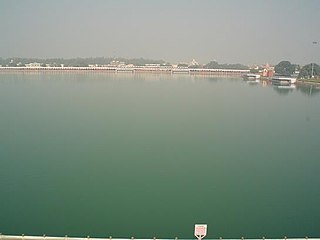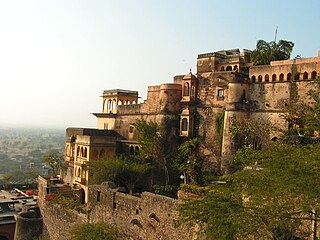
Thanesar is a historic city and an important Hindu pilgrimage centre in Kurukshetra district of the state of Haryana in northern India. It is located in Kurukshetra district, approximately 160 km northwest of Delhi. Kurukshetra's area merges with Thanesar.

Kurukshetra is a city and administrative headquarters of Kurukshetra district in the Indian state of Haryana. It is also known as Dharmakshetra and as the "Land of the Bhagavad Gita".

Bahadurgarh is a city and municipal council, nearby Jhajjar City, is located in Jhajjar district in the Indian state of Haryana. The city comprises 31 wards and is approximately 21 km from National Capital Territory (NCT) of Delhi and 31 km from Jhajjar, the district headquarter.

Gharaunda is a town and a municipal committee in Karnal district in the state of Haryana, India. It is situated at a distance of sixty-five miles to the northwest of New Delhi. It is eleven miles from Karnal, the district headquarters. The Amritsar-Delhi main broad-gauge railway line passes through the town. Indo-Israel Centre For Excellence in Vegetables and one of the leading footwear industries of India 'Liberty Shoes' has its manufacturing unit in Gharaunda. This has given fame to the place. Gharaunda serves as a big Grain market for the state.

Pinjore is a town in Panchkula district in the Indian state of Haryana. This residential 'township', located close to Panchkula, Chandigarh, is set over 1,800 feet above the sea level in a valley, overlooking the Sivalik Hills. Pinjore is known for Pinjore Gardens, Asia's best 17th Century Mughal garden, and the Hindustan Machine Tools (HMT) factory.

Haryana Tourism Corporation (HTC) was constituted as a Public Limited Company under the Companies Act, 1956 on 1 May 1974. As an agent of the Government of Haryana, Haryana Tourism Corporation runs and maintains 44 Tourist Complexes spread across the state of Haryana. These Tourist Complexes offer visitors lodging, dining, recreational activities, Restaurant, Bars, Liquor Vends, Tourist taxis, Petrol Pumps, Swimming Pool, Health Club, Golf Club, Lakes, boating, etc.

Delhi Sarai Rohilla railway station is situated about 4 kilometres from old Delhi railway junction in India. It is managed by Delhi Division of Northern Railway zone. Many trains from Delhi to Haryana,Jammu and Kashmir,Punjab, Rajasthan,Karnataka, Gujarat and Maharashtra stop at this station. More than twenty trains including Duronto and AC trains originate at this station.

Mughal Serai, Doraha or Doraha Sarai is located at Doraha in Ludhiana District. Its popularly known as 'Mughal Caravan Serai'. This is often confused with this place as RDB fort. RDB fort, the fort shown in movie Rang De Basanti, is situated at 8-9 km distance from this.
Badshapur is one of the 4 sub-division of Gurugram district of Haryana state, situated on the Gurugram-Sohna road (NH-248A). It is a Yadav dominated area in Gurgaon. It is named after the Badshahpur Fort, which in turn was the abode of the wife of Mughal Emperor Bahadur Shah Zafar. Badshahpur is a part of Badshahpur assembly constituency of Haryana.
Aphariya (Abhirya) also spelt as Affariya, Afariya or Phariya) is a clan of Yaduvanshi Aheer or Yadava. Aphariyas ruled the Ahirwal state of Haryana.

Sheikh Chilli's Tomb is complex of structures located in Thanesar, in the Kurukshetra district of Haryana, India. It includes two tombs, a madrasa, Mughal gardens and various subsequent features.

The Akbari Sarai is a large caravan inn ("sarai"), located in Shahdara Bagh in Lahore, Punjab, Pakistan. Dating from 1637, the sarai was originally built for travelers, as well as for caretakers of the Tomb of Jahangir. The sarai is most notable for being the best-preserved example in Pakistan, as well as for its large gateway that is richly embellished with pietra dura that serves as a portal to the tomb of Jahangir.

The Tomb of Asif Khan is a 17th-century mausoleum located in Shahdara Bagh, in the city of Lahore, Punjab. It was built for the Mughal statesman Mirza Abul Hassan Jah, who was titled Asif Khan. Asif Khan was brother of Nur Jahan, and brother-in-law to the Mughal Emperor Jahangir. Asif Khan's tomb is located adjacent to the Tomb of Jahangir, and near the Tomb of Nur Jahan. Asif Khan's tomb was built in a Central Asian architectural style, and stands in the centre of a Persian-style Charbagh garden.

Madhogarh Fort is a fort located on top of Madhogarh Hill in the Aravalli mountain range, near Madhogarh village, in the Mahendragarh district of Haryana state in India. It is located 12 kilometres (7.5 mi) from Mahendragarh, reachable via Satnali Chowk or via Mahendragarh- Satnali- Loharu road.
Tourism in Haryana relates to tourism in the state of Haryana, India. There are 21 tourism hubs created by Haryana Tourism Corporation (HTC), which are located in Ambala, Bhiwani Faridabad, Fatehabad, Gurgaon, Hisar, Jhajjar, Jind, Kaithal, Karnal, Kurukshetra, Panchkula, Sirsa, Sonipat, Panipat, Rewari, Rohtak, Yamunanagar, Palwal and Mahendergarh.
Pathar Masjid (Thanesar) is a mosque build of red sandstone in Mughal architecture style. The fluted minarets are attached to the back walls. Believed to be built in 17th century, the mosque is located in Thanesar and is protected by the Government of India. The ceiling that rests on pillars is decorated by carved floral designs. It is situated near the tomb of Sheikh Chilli.

The Mughal Sarai is a caravanserai located in Surat, Gujarat, India.
The Mosque of Ala Vardi Khan is a mosque and a government of India protected monument.
The archaeological excavations located on the outskirts of the city of Kurukshetra. Kurukshetra, District : Kurukshetra, Adjacent to Sheikh Chilli's Tomb, Excavation revealed antiquities from first millenium BCE to 19th century related to Vedic & Late Vedic periods, and at least six other subsequent cultural and historical periods. Site was abandoned after the vedic period in the first millennium BCE, then continuously habited from 1st century CE to 19th century. The site, spread over an area of 1 km x750 m x 23 m, containts historical remnants belonging to vedic as well as six continuously habited post-vedic periods ranging from Kushan to Mughal era.
Ashoka Lat of Feroz Shah is a pillar located in Fatehabad, Haryana. The height of the pillar is 6 metres. This pillar is believed to be the lower part of the original pillar that was erected by Ashoka in Hansi. As was the tradition to demolish existing Hindu temple and architecture and use the debris to erect new monument - Feroz Shah also took a part of the original pillar and planted it at Fatehabad. However, the Ashokan epigraph was chiseled out and new Tughlaq inscriptions were engraved. The inscriptions are the genealogy of Firoz Shah. It is believed to be planted in 1351-88 AD.












